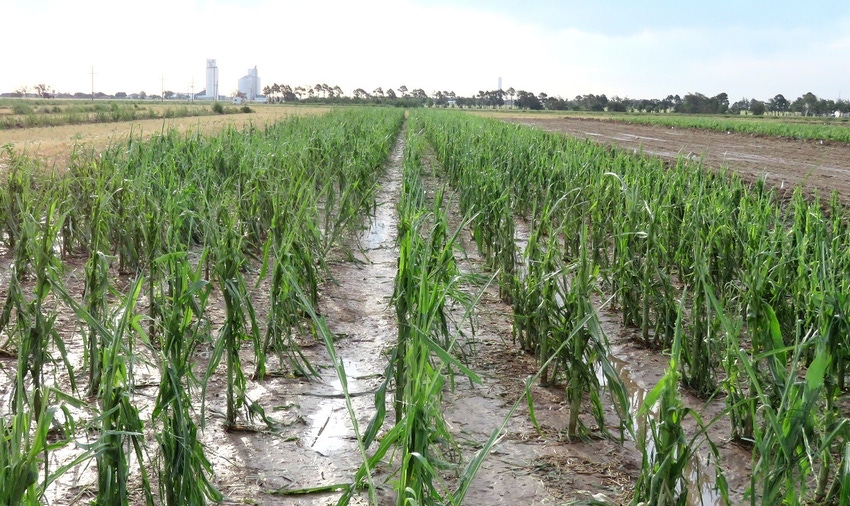
Everything from mature wheat awaiting harvest to growing fields of cotton, corn, sorghum, sunflowers and vegetables have been shredded to varying degrees by waves of hail storms across the High Plains and South Plains of Texas, affecting many acres of crops as recently as July 4. Hailstones ranged from pea- to golf ball-size, according to the Texas A&M AgriLife Extension Service reports.
“For all crops, it is best to be patient and assess damage several days after the storm,” said Dr. Jourdan Bell, AgriLife Extension agronomist in Amarillo. “Although at this time, it appears the biggest losses are in cotton.”
Much of the cotton hit by hail may suffer significant yield loss, Bell said.
“We have plots on the Bushland research station where we lost all of the leaves and the terminal is damaged. Because we do not have sufficient growing season left for a full recovery, these plots are a full loss in our region.”
Forage and grain sorghum in earlier vegetative growth stages will most likely recover with minimal yield loss, she said. Especially for grain sorghum, yield losses are reduced when the growing point is below the soil surface.
Corn’s growing point is below ground until the plant reaches the six-leaf stage, Bell said. When the growing point moves above the soil surface, the plant is more susceptible to hail damage. The growing point is the area in the stem where the leaves and the tassel initiate.
REPLANT OPTIONS
When assessing damage in cotton, research has shown that a population as low as 20,000 plants per acre can partially compensate for the reduced stand, although this will vary with the degree of damage, she said.
If Panhandle producers decide to replant, Bell said they will need to evaluate the optimum planting dates for crops such as sunflowers and grain sorghum because early July is generally the last planting date. Silage might be an option for the damaged corn crop for producers located close to dairies and feedyards, but will depend on contract availability.
“If you are considering replanting with sorghum, you will need an early maturing hybrid to finish before the freeze in the fall here in the Panhandle,” she said. “Generally, the week of July 4 is considered the last planting date for early maturing grain sorghum in the Panhandle region due to the risk of the crop not maturing before a freeze.”
Dr. Ed Bynum, AgriLife Extension entomologist in Amarillo, said producers planting grain sorghum need to be aware the sugarcane aphid will still be a concern in late-planted sorghum.
Bell said producers also need to consider the herbicides they used in cotton when considering their cropping rotation.
“We have a lot of late-planted corn that was in vegetative stages of development that will survive with varying degrees of yield loss,” she said. “But some that was planted in early May has reached tassel – tasseling corn will likely be a 100 percent loss if hit by hail because there is no longer a pollen source for fertilization.”
For corn and sorghum, when the crop is still in the vegetative stages, producers are generally not looking at 100 percent crop loss, Bell said. Corn hit before the six-leaf stage will generally recover with less than 10 percent yield loss. For those with more mature corn, yield losses will increase with each advanced leaf stage and leaf loss until tasseling.
LOSS POTENTIAL
“During the later reproductive stages especially after blister, maximum losses due to hail damage are usually less than 75 percent in the most severe cases to less than 10 percent in situations where fewer leaves are lost,” she said.
However, final crop loss will be dependent on the growth stage when the damage occurred, producer inputs and continuing growing-season conditions, Bell said.
“Damage will also depend on the size of the hail,” she said. “Corn hit by small hail that just shreds leaves will recover more quickly with less yield loss than corn hit by larger hail stones that bruise the stalk and make the corn more susceptible to lodging and diseases later in the season.”
After the eight- to nine-leaf stage, significant injury can occur in the development of the ear shoot, Bell said. The growing point is above the soil surface and the developing ear shoots are in the lower regions of the stalk where they are still susceptible to damage from large stones.
“One of the challenges for our corn farmers who have experienced hail damage, ultimately, will be that at the current lower commodity prices, any reduction in yield potential is significantly affecting their very narrow profit margin,” she said.
For more extensive planning, Bell said farmers can access these publications: http://bit.ly/2tIXxks, http://bit.ly/2tJ0K3v, http://bit.ly/2tMvTT7 and http://bit.ly/2tlt6ja.
About the Author(s)
You May Also Like




